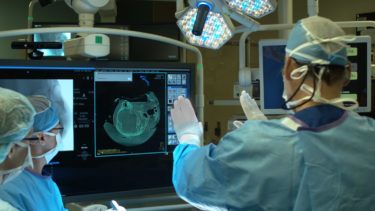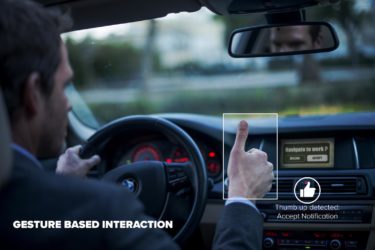Gesture control technology can now turn any object into a remote control using cameras and is revolutionising industries, but is it making society more dependent?
What is gesture control technology?
Almost all gadgets today are camera-enabled. Smart phones, tablets, PCs, TVs, even automobiles include one or more cameras. These cameras are revolutionizing the way we use and interact with these devices.
Through image sensors and embedded vision algorithms, a camera is able to interpret and detect hand and body movements, essentially allowing us to use a device without actually having to pick it up or touch it.
Tied with advanced technologies such as face recognition and voice commands, our experience with tech gadgets is notably more intuitive and effortless.
However convenient these developments are, there is an argument that gesture control technology is somewhat making our lives a little too easy.
Is gesture control tech allowing us to become lazy and too dependent?
One only has to think of the excitement of playing with Wii consoles, to remember that thanks to motion and gesture sensor technology you could go bowling or play golf without having to leave the house. In fact, you didn’t even need to get off the couch, an occasional flick of your wrist could allow you to maintain a steady rally in a Wii tennis match.
Although the intentions of Wii were partially to get people on their feet to mimic the movements of the game, it seems sitting slumped on your sofa works just as well. Why go outside and do actual exercise when gesture control technology allows you to do it in your living room?
If you thought the Wii was essentially lazy, now, technology has advanced to a stage where you don’t even need a console or remote to play a game, or even change the channel on your TV.
Recent developments in gesture control
Researchers from Lancaster University School of Computing and Communications have developed a novel technique that allows objects or body movements to interact with screens, in other words, turning everyday objects into remote controls. This ¨Matchpoint¨ technology, requires merely a webcam and works by matching gesture motions carried out by any object with an onscreen rotating icon. The icons correspond to different functions such as volume control, menu options and changing the channel. The user can synchronize the movement of the object with the direction of the icon to achieve what the researchers have called ´spontaneous spatial coupling´, activating the desired function.
Matchpoint technology has made it possible for couch potatoes to become even more sedentary, with the simple movement of their cup of tea, or bottle of beer, and they can effortlessly control the TV. The days of dismantling the sofa in search for the remote are soon to be over.

Christopher Clarke, PhD Student at Lancaster University
Christopher Clarke, PhD student at Lancaster University and developer of the technology explains that yes, the technology makes a lazy activity such as watching tv even more inactive, however it also can be used to help and improve other daily activities that go beyond leisure.
Clarke says on the university blog, “Our method allows for a much more user-friendly experience where you can change channels without having to put down your drink, or change your position, whether that is relaxing on the sofa or standing in the kitchen following a recipe.”
The PhD student further insinuates that this technology is a perfect application for those with mobility issues, or who are unable to reach for a separate specific controller.
Industries being transformed by gesture control
This new technology therefore goes far beyond just changing the channel. It´s usefulness outshines its promotion of indolent activity, especially when used outside the circle of consumer devices such as TVs. The same technology can be used on screens showing instructions, or recipes. Lets face it, since the birth of Google, instruction manuals and recipes books are a thing of the past. When hands are tied or dirty, a quick movement of a bike tool, or cooking spatula, can pause or rewind tutorials in a clean, efficient and safe way.
This same gesture recognition exists in medical applications, for similar reasons. During surgery a nurse or doctor may not be able to touch a screen or trackpad that controls a system, for health and safety reasons, but with gesture control technology, hand or finger movements can be used as a virtual mouse to control the device.

Gesture control technology used in operating theaters
Despite the opinions on how technology advances are creating a lazy, inert society, gesture control technology is not something we should be criticising. It is part of a new wave of electronic innovations which are improving aspects of life in terms of efficiency, safety and education. Intel® RealSense™ technology is using it in classrooms to make education more enjoyable and interactive. Intel created an application, called ARPedia to provide students with a digital exploration of the encyclopedia. It too uses gesture control recognition to show, for an example, how a dinosaur grows, with functions allowing the user to interact with hand gestures.
GestureTek Health have created interactive road safety learning experiences as well as gesture-controlled interactive displays in healthcare facilities providing visitors and patients with information. Cognivue have installed gesture control onto sliding car doors for convenience, and have also employed this technology in the rear of the vehicle to provide assistance with reversing, and in the side mirrors for blind spot warning. More recently, Jabil Inc. and eyeSight Technologies have teamed up to deliver advanced levels of gesture controls whilst driving, turning an action such as answering an incoming cell phone call into a safer hand gesture.

Jabil Inc uses gesture control technology making driving safer
The possibilities of what gesture recognition technology could provide are endless. The emergence of new tech products and software is always followed by the argument that it makes us lazier. However, changing the volume of your tv with your pet cat, or waving your hand in the effort to control a game is only one level of what this new gesture control technology can achieve.










